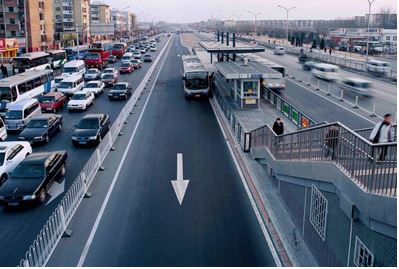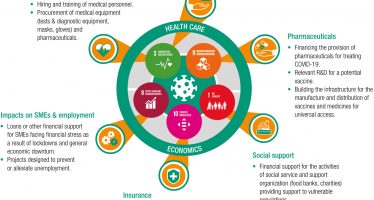New Study Adds Up the Benefits of Climate-Smart Development in Lives, Jobs, and GDP
- With careful design, the same development projects that improve communities, save lives, and increase GDP can also fight climate change.
- A new study examines the multiple benefits for a series of policy scenarios addressing transportation and energy efficiency in buildings and industry in five countries and the European Union.
- It provides concrete data to help policymakers understand the broader potential of climate-smart development investments.

Bus rapid transit systems that shift commuters to faster public systems take cars off the road, create jobs, and reduce pollution that damages health and contributes to climate change.
Sam Zimmerman/World Bank
Modernizing landfills and cleaning up open dumps have obvious benefits for surrounding communities, but the value reaches deeper into the national budget that may be evident at first glance.
For a country like Brazil, where waste-to-energy technology is being piloted today, integrated solid waste management practices including building sanitary landfills that capture greenhouse gas emissions to generate electricity can improve human health, add jobs, increase the energy supply, reduce the impact on climate change, and boost national GDP.
A new study looks at a series of climate-smart development project scenarios, including landfills in Brazil, and for the first time on a large scale adds up how government actions can boost economic performance and benefit lives, jobs, crops, energy, and GDP – as well as emissions reductions to combat climate change.
It provides concrete data to help policymakers understand the broader potential of climate-smart development investments.
“Climate change poses a severe risk to global economic stability, but it doesn’t have to be like this,” said World Bank Group President Jim Yong Kim. “At the World Bank Group, we believe it’s possible to reduce emissions and deliver jobs and economic opportunity, while also cutting health care and energy costs. This report provides powerful evidence in support of that view.”
The report, Climate-Smart Development: Adding Up the Benefits of Actions that Help Build Prosperity, End Poverty and Combat Climate Change, focuses on five large countries – Brazil, China, India, Mexico, and the United States – plus the European Union. It examines the benefits of all six implementing three sets of policies on clean transportation, energy efficiency in industry, and energy efficiency in buildings.
“This study makes the case for actions that save lives, create jobs, grow economies and, at the same time, slow the rate of climate change. We place ourselves and our children at peril if we ignore these opportunities.”
– Rachel Kyte, World Bank Group Vice President & Special Envoy for Climate Change
In the transportation policy scenario, for example, if the five countries and the EU shifted more travel to public transit, moved more fright traffic off of roads to rails and sea, and improved fuel efficiency, they could save about 20,000 lives a year, avert hundreds of millions of dollars in crop losses, save nearly $300 billion in energy, and reduce climate changing emissions by more than four gigatons.
It also looks at the potential impact of four country-specific projects, including landfills in Brazil, if they were scaled to the national level.
Short-Lived Climate Pollutants
Some of the benefit comes from reducing emissions of what are known as short-lived climate pollutants, or SLCPs.
Black carbon from diesel vehicles and cooking fires, methane from mining operations and landfills, ozone formed when sunlight interacts with emissions from power plants and vehicles, and some hydrofluorocarbons are all SLCPs. They can damage crops and cause illnesses that kill millions. Reducing these emissions could avoid an estimated 2.4 million premature deaths and about 32 million tons of crop losses a year.
Unlike CO2, SLCPs do not linger in the atmosphere for centuries but are removed in weeks or years. Stopping these air pollution emissions from entering the atmosphere would by itself help reduce warming and provide time to develop and deploy effective CO2 interventions.
Adding up the Benefits
Until now, socioeconomic benefits and environmental externalities, those consequences of industrial or commercial activities not reflected in their costs, have often been left out of economic analysis because they have been difficult to measure.
This report introduces a new macroeconomic modeling framework that can incorporate these considerations, providing a more holistic analysis of the co-benefits of development investments. The new modeling tools:
- Measure the multiple benefits of reducing emissions of several pollutants.
- Can be used to better design and analyze policies and projects.
- Provide a rationale for combining climate action with sustainable development.
This report utilizes the new framework in seven simulated case studies – three dealing with sector policies and four focused on project level interventions – to calculate the many benefits of air pollution reduction.
The sector policies include regulations, taxes, and incentives to stimulate a shift to clean transportation, improved industrial energy efficiency, and more energy efficient buildings and appliances.
By 2030, the benefits of these three sets of sector policies would include 94,000 premature deaths avoided annually and GDP growth of $1.8 trillion-$2.6 trillion per year. The policies would avoid 8.5 gigatons of CO2-equivalent and almost 16 billion kilowatt-hours of energy saved, roughly equivalent to taking 2 billion cars off the road. Together, these implementing these policies could represent about 30 percent of the total reduction needed in 2030 to limit global warming to 2 degrees Celsius.
The four simulated project case studies analyzed local development interventions scaled up to a national level in one country.
For example, in the Brazil landfill scenario, the report uses results from existing World Bank-supported projects in Brazil that are implementing a variety of integrated solid waste management options, including biodigesters, composting, and landfill technology that captures methane to produce electricity. If the same technologies were scaled up nationwide, over 20 years, the study estimates the changes could create more than 44,000 jobs, increase GDP by more than $13 billion, and reduce emissions by 158 million tons of CO2-equivalent.
The other three project case studies examine expanding bus rapid transit in India, the use of clean cookstoves in rural China, and the use of solar panels and biodigesters to produce electricity from agriculture waste in Mexico.
Together, the aggregate benefits over 20 years of those four projects scaled up to the national level are estimated to include more than 1 million lives saved and about 1 million-1.5 million tons of crop losses avoided. These projects could reduce CO2-equivalent, emissions roughly equivalent to shutting down 100-150 coal-fired power plants. For just three of these projects – in India, Brazil, and Mexico – the benefits equate to about $100 billion-$134 billion in additional value.
Inaction Raises the Cost
While highlighting the co-benefits, the case studies suggest the need for further development of the modeling framework. Nevertheless, the framework demonstrates that capturing environmental externalities can strengthen the rationale for projects or policies aimed at controlling air pollutants.
As the recent Intergovernmental Panel on Climate Change assessment urged, climate action can become much easier to undertake if co-benefits are captured and quantified.
“Climate inaction inflicts costs that escalate every day,” says Rachel Kyte, World Bank Group vice president and special envoy for climate change. “This study makes the case for actions that save lives, create jobs, grow economies and, at the same time, slow the rate of climate change. We place ourselves and our children at peril if we ignore these opportunities.”
You may have an interest in also reading…
Know the Risks and ‘See’ the Future with the Integrity and Transparency of Moody’s Local
The Moody’s name and brand is internationally famous — and the agency’s Latin American platform brings local knowledge to the
Building Bridges: Joining Impact Investing and Social Entrepreneurship
Finance is stepping up to a growing impetus from stakeholders to transform society for the better. Yet, there is a
UNCTAD: COVID-19 Has Hurt Global Investment but the Recovery Offers the Chance to Build a More Sustainable Economy
The crisis caused by the COVID-19 pandemic has severely impacted investment and trade flows, but it arrives on top of



















































































